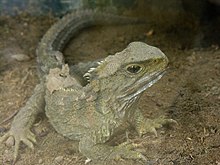Hatteria punctata
| Tuatara Temporal range: – present,0.126–0 Ma |
|
|---|---|
 |
|
| Male northern tuatara (Sphenodon punctatus) | |
| Scientific classification | |
| Kingdom: | Animalia |
| Phylum: | Chordata |
| Class: | Reptilia |
| Order: | Rhynchocephalia |
| Family: | Sphenodontidae |
| Genus: |
Sphenodon Gray, 1831 (conserved name) |
| Type species | |
|
Hatteria punctata Gray, 1842 |
|
| Species | |
|
|
 |
|
| Native range (New Zealand) | |
| Synonyms | |
|
|
Tuatara are reptiles endemic to New Zealand. Although resembling most lizards, they are part of a distinct lineage, the order Rhynchocephalia. Their name derives from the Māori language, and means "peaks on the back". The single species of tuatara is the only surviving member of its order, which flourished around 200 million years ago. Their most recent common ancestor with any other extant group is with the squamates (lizards and snakes). For this reason, tuatara are of great interest in the study of the evolution of lizards and snakes, and for the reconstruction of the appearance and habits of the earliest diapsids, a group of amniote tetrapods that also includes dinosaurs, birds, and crocodilians.
Tuatara are greenish brown and grey, and measure up to 80 cm (31 in) from head to tail-tip and weigh up to 1.3 kg (2.9 lb) with a spiny crest along the back, especially pronounced in males. Their dentition, in which two rows of teeth in the upper jaw overlap one row on the lower jaw, is unique among living species. They are even more unusual in having a pronounced photoreceptive eye, the "third eye", which is thought to be involved in setting circadian and seasonal cycles. They are able to hear, although no external ear is present, and have a number of unique features in their skeleton, some of them apparently evolutionarily retained from fish. Although tuatara are sometimes called "living fossils", recent anatomical work has shown that they have changed significantly since the Mesozoic era. While mapping its genome, researchers have discovered that the species has between five and six billion base pairs of DNA sequence.
...
Wikipedia
